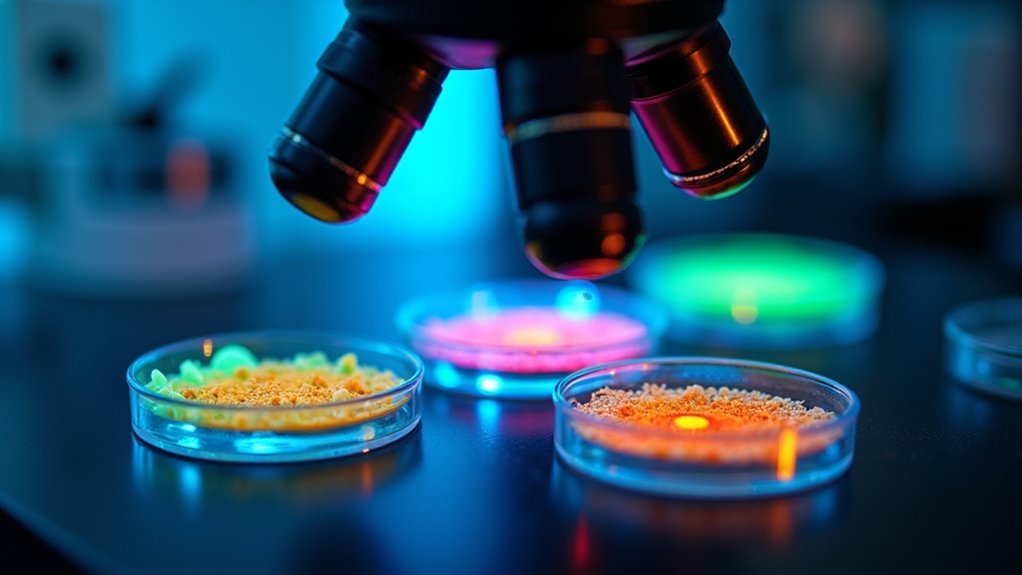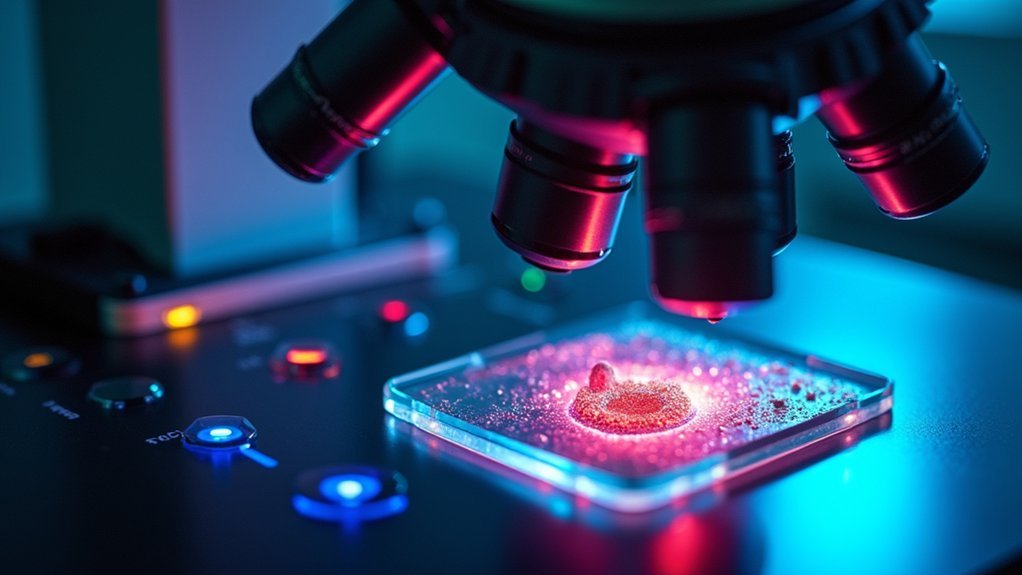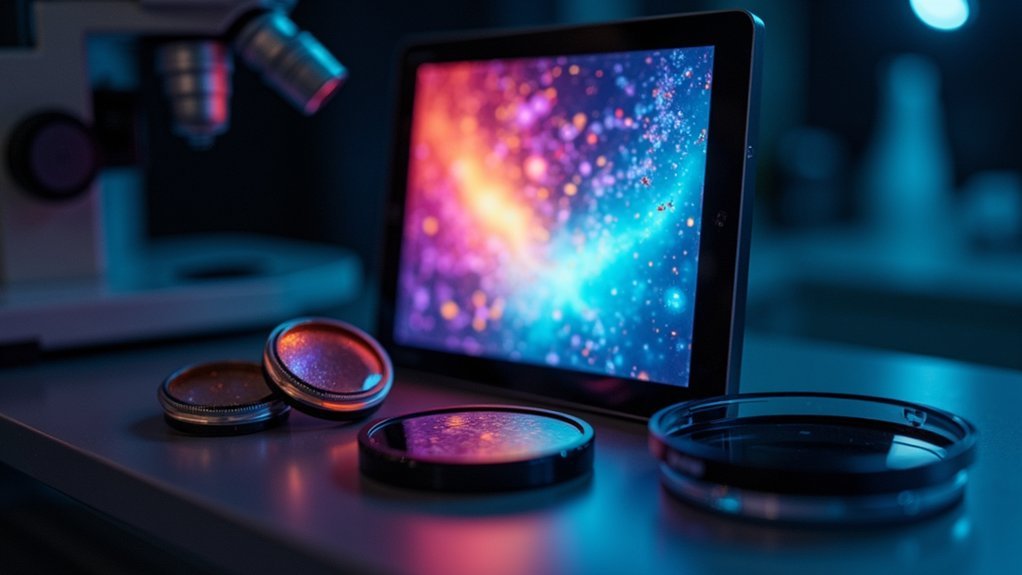To reduce confocal image noise, start with proper sample preparation using high-quality fluorophores. Optimize your settings by using moderate gain, setting pinhole to 1-1.5 Airy units, and applying line averaging (4-8 scans). Increase laser power gradually while monitoring photobleaching. Implement frame accumulation for temporal noise reduction and consider post-acquisition deconvolution for further clarity. These foundational adjustments will dramatically improve your image quality before exploring more advanced techniques.
Simple Steps To Reduce Confocal Image Noise

Eliminating noise from confocal microscopy images dramatically improves data quality and interpretation accuracy.
You’ll achieve cleaner results by implementing both spatial and frequency domain filtering techniques. Try median filtering to reduce noise while preserving critical edge details in your image.
Optimize your SNR by adjusting camera gain settings and exposure time to balance brightness against background noise. For significant noise reduction, capture multiple scans and apply averaging techniques to statistically minimize random fluctuations in pixel intensities.
Precise gain and exposure adjustments paired with multi-scan averaging significantly boost signal clarity while preserving critical image details.
When working with particularly challenging samples, implement advanced denoising algorithms like Noise2Void, which can enhance image quality from single scans without extensive training requirements.
These approaches target high-frequency noise while retaining important structural information, ensuring your confocal data remains scientifically valid while appearing visually cleaner.
Understanding Sources of Noise in Confocal Microscopy
Understanding the noise in your confocal images requires recognizing three primary culprits: shot noise from the Poisson distribution of photon detection, electronic interference like thermal and readout noise from your camera sensors, and sample-specific issues including background reflections and focus variability.
Shot noise becomes particularly problematic at low signal intensities, where the random fluctuations in photon counts can greatly mask your biological signals.
Your imaging results will improve dramatically once you’ve identified whether your noise originates from the photon statistics, your detection system, or the sample preparation itself.
Shot Noise Fundamentals
When capturing images with a confocal microscope, you’re inevitably confronted with shot noise, a fundamental limitation arising from the quantum nature of light itself. This statistical fluctuation follows a Poisson distribution where noise increases with the square root of detected photoelectrons (±√N).
To improve your signal-to-noise ratio, you’ll need to optimize several parameters:
| Parameter | Effect on Shot Noise |
|---|---|
| Exposure time | Longer times collect more photons, reducing relative noise |
| Light intensity | Higher intensity increases signal above noise floor |
| Gain settings | Lower gains minimize amplification of noise |
| Scanning speed | Slower scanning improves photon collection |
| Averaging | Multiple scans statistically reduce noise effects |
For weak fluorescent signals, increasing your exposure time is particularly effective, allowing more photons to be detected and statistical fluctuations to average out.
Electronic Signal Interference
While shot noise represents the quantum limitation of light detection, your confocal microscope faces additional electronic challenges that can degrade image quality.
Electronic interference considerably impacts your signal-to-noise ratio through several mechanisms.
- Thermal noise disrupts silicon bonds in sensors, creating unwanted electronic fluctuations that manifest as image artifacts, especially during longer imaging sessions when heat builds up.
- Camera noise introduces variability through both readout noise (during signal conversion) and thermal electrons (temperature-dependent), with performance varying greatly between different camera designs.
- Amplifier noise occurs during the critical conversion of photoelectrons to digital signals, adding another layer of interference that compounds with other noise sources.
Environmental light reflecting off slides further contributes to background noise, making controlled imaging conditions essential for ideal results.
Sample-Related Noise Sources
Beyond electronic interference, your samples themselves introduce significant noise factors that can dramatically affect image quality.
Biological background noise, such as autofluorescence and non-specific staining, can mask true signals in your images, compromising data integrity.
Inconsistencies in sample preparation—varying dye concentrations or incubation times—lead to fluorescence variability that affects quantitative analysis.
Spherical aberration, resulting from refractive index mismatches between your sample and immersion medium, becomes particularly problematic in thicker specimens.
Watch for fluorophore aggregation artifacts that create misleading signal clusters and intensify sample-related noise.
Light scattering increases with sample depth and density, reducing signal clarity especially in complex tissues.
Understanding these noise sources allows you to develop targeted strategies for cleaner, more accurate confocal images.
Optimizing Detector Gain and Offset Settings
The foundation of quality confocal microscopy lies in properly calibrated detector settings. Finding the ideal detector gain helps amplify true signals without excessive noise, directly improving your signal-to-noise ratio (SNR).
Meanwhile, careful adjustment of offset settings establishes a baseline that prevents bright signal saturation while preserving dimmer features.
To achieve ideal results:
- Start with moderate gain settings, then adjust incrementally until faint signals become visible without introducing excessive noise.
- Monitor your histogram in real-time to visually assess how adjustments affect image brightness and contrast.
- Regularly recalibrate both gain and offset settings for different samples, as ideal values vary with specimen characteristics.
Remember that higher gain can reveal faint signals but also amplifies noise—finding this balance is critical for producing consistently high-quality confocal images.
Leveraging Line Averaging for Cleaner Images

Among the most effective techniques for noise reduction in confocal microscopy, line averaging stands out for its simplicity and power. By capturing multiple scans of the same image and calculating mean pixel values, you’ll greatly enhance your signal-to-noise ratio while stabilizing background noise.
Line averaging elevates confocal microscopy through elegant simplicity—multiple scans merge into clean signals amid chaotic noise.
This method particularly shines when working with specimens that produce high noise levels, as it smooths out random intensity fluctuations that might otherwise mask critical details.
When implementing line averaging, carefully monitor your 8-bit images to prevent saturation, which can compromise data integrity.
For best results, strike a balance between the number of averages and practical considerations like scan time and sample viability. Remember that each additional scan improves image quality but extends exposure time—a trade-off you’ll need to evaluate based on your specific imaging needs.
Frame Accumulation Techniques for Signal Enhancement
Frame accumulation boosts your confocal image quality by scanning the same area multiple times and adding the signal values from each pass.
You’ll notice significant temporal noise reduction as random fluctuations average out while your true signal strengthens through sequential scan integration.
When properly calibrated, this technique can reveal previously undetectable structures in your samples without increasing laser power, protecting your specimens from potential photodamage.
Multiple Frame Averaging
When dealing with confocal images plagued by noise, multiple frame averaging stands out as a powerful solution. This technique scans the same image repeatedly, calculating mean pixel intensities to reduce random noise while enhancing your signal-to-noise ratio (SNR).
Unlike frame accumulation which adds pixel values (risking saturation in 8-bit images), averaging stabilizes background noise for clearer signal identification.
To maximize your imaging results:
- Combine line averaging with frame accumulation to improve image quality while increasing detected signals
- Calibrate your settings using the brightest samples first to prevent saturation-related inaccuracies
- Monitor your high SNR improvements by comparing single scans with averaged images to confirm noise reduction
This balanced approach delivers cleaner images while preserving the integrity of your valuable research data.
Sequential Scan Integration
Unlike single captures that often fall prey to shot noise, sequential scan integration enhances your confocal images by systematically accumulating multiple frames from the same region. This technique calculates the mean pixel intensity across frames, dramatically improving your signal-to-noise ratio while preserving important structural details.
When implementing frame accumulation, watch your intensity settings carefully. If pixel values exceed your bit depth maximum (such as 255 for 8-bit images), you’ll lose valuable detail through saturation. For best results, combine this approach with line averaging for maximum flexibility.
Remember to balance your total scan time against potential photobleaching effects. By carefully adjusting your frame accumulation parameters, you’ll capture clearer images with enhanced signal detection while maintaining sample integrity during extended imaging sessions.
Temporal Noise Reduction
Temporal noise poses a significant challenge in confocal microscopy, particularly when imaging dim or fast-bleaching specimens.
Frame accumulation techniques can dramatically enhance your image quality by combining multiple captures to boost pixel intensity while reducing random fluctuations.
When implementing frame accumulation for superior image analysis, focus on:
- Calibrating accumulation settings based on your brightest samples to prevent 8-bit saturation (exceeding 255)
- Optimizing frame numbers to balance scan time against signal strength for higher SNR
- Averaging accumulated frames to decrease noise fluctuations while preserving true signals
This approach gives you remarkable flexibility to capture clearer images of challenging specimens without compromising their integrity.
The enhanced SNR reveals details previously hidden by noise, providing more reliable data for quantitative analysis.
Adjusting Pinhole Settings to Control Background Noise
The pinhole diameter represents one of the most critical adjustments you can make to reduce background noise in confocal microscopy. By setting your pinhole between 1.0 and 1.5 Airy units, you’ll achieve a favorable balance between signal strength and noise reduction. Smaller pinholes effectively block out-of-focus light, greatly enhancing your signal-to-noise ratio.
However, don’t automatically choose the smallest setting. Excessively small pinholes can actually diminish overall signal intensity and resolution.
Consider your imaging depth when selecting pinhole size – deeper imaging typically requires larger pinholes to collect sufficient signal while still managing background noise.
During your initial imaging sessions, experiment with different pinhole settings. This hands-on approach will help you identify the ideal configuration for your specific sample while maintaining adequate signal strength.
Selecting Appropriate Laser Power to Minimize Photodamage

When setting up your confocal microscope, you’ll need to find the ideal laser power that provides sufficient signal without damaging your sample.
Start with the lowest intensity possible (typically 1-5% of maximum output) and gradually increase until you achieve adequate detection while monitoring for signs of photobleaching.
You can protect sensitive biological specimens by regularly evaluating the trade-off between image quality and photodamage, using automated power adjustment features when available to maintain sample integrity during longer imaging sessions.
Finding Optimal Intensity
Selecting the ideal laser power represents perhaps the most critical balancing act in confocal microscopy, as you’ll need to achieve sufficient signal strength without damaging your sample.
Start with lower excitation light intensity (typically 1-10% of maximum power) and gradually increase until you achieve adequate signal quality without saturation.
To determine your best intensity:
- Begin at a low power setting (1-2%) and capture test images, increasing incrementally until signal becomes clearly visible.
- Monitor fluorescence intensity in real-time to identify the point where higher power yields diminishing returns.
- Consider combining lower laser power with shorter exposure times to minimize photodamage while maintaining image clarity.
Balancing Signal Protection
While ideal intensity focuses on achieving clear visibility, proper signal protection requires understanding the biological cost of excessive illumination. Selecting appropriate laser power is critical to prevent cellular damage while maintaining adequate signal intensity for your confocal imaging.
Start with the lowest effective power setting—typically 30-50% of maximum output—and increase incrementally only when necessary. This approach preserves sample integrity without compromising data quality.
During live cell imaging, be particularly vigilant about power settings, as even minor photodamage can notably alter cellular behavior and experimental outcomes.
Consider implementing time-lapse imaging with reduced laser power to extend viable observation periods. By monitoring your sample’s response throughout imaging sessions, you’ll quickly identify the sweet spot between sufficient signal detection and minimal photodamage.
Z-Stack Optimization for Improved Signal-to-Noise Ratio
To achieve high-quality confocal microscopy data, proper z-stack refinement serves as a cornerstone technique for maximizing signal-to-noise ratio. When planning your z-stack acquisition, select a step size of 0.5-1.0 times your system’s axial resolution to capture sufficient signal without unnecessary overlap that introduces noise.
For best results in noise reduction:
- Maintain consistent laser intensity and exposure settings across all z-planes to guarantee uniform signal-to-noise ratio throughout the stack.
- Adjust your pinhole size appropriately—smaller pinholes improve resolution and depth discrimination, reducing noise from out-of-focus planes.
- Implement averaging techniques by collecting multiple scans per z-plane to minimize random noise while preserving true signal.
Always check focus alignment throughout acquisition to prevent spherical aberration artifacts that can degrade your deeper z-slices.
Post-Processing Filters for Noise Reduction

After acquisition, your confocal images often benefit greatly from targeted post-processing filters that can dramatically improve signal quality.
Median filtering effectively removes impulse noise while preserving essential edge details by substituting pixel values with the median of surrounding pixels.
When dealing with broader noise patterns, you’ll find Gaussian filtering useful, though be careful as it may blur fine structures.
For more complex noise issues, consider frequency domain approaches that target specific noise components that spatial filters might miss.
For ideal results, explore deconvolution techniques like the Richardson-Lucy algorithm, which can restore clarity by addressing both noise and optical distortions.
The Wiener filter offers an advanced solution for challenging images by utilizing PSF data to balance noise reduction with detail preservation.
Sample Preparation Methods to Enhance Signal Quality
Proper sample preparation forms the foundation of high-quality confocal imaging, often determining whether you’ll spend hours troubleshooting noise issues or immediately capture publication-ready data.
Sample preparation is the cornerstone of confocal success—the difference between data frustration and imaging celebration.
Meticulous sample preparation dramatically reduces background noise while maximizing signal intensity.
To enhance your specimens for superior confocal results:
- Fix and stain appropriately – Use ideal fixation protocols and select high quantum efficiency fluorophores to enhance specific signals while minimizing non-specific background.
- Ensure clean, debris-free mounting – Remove all contaminants and use mounting media with matching refractive indexes to improve optical clarity and reduce aberrations.
- Apply appropriate clearing techniques – For thicker samples, implement clearing methods to improve light penetration, reduce scattering, and eliminate artifacts that contribute to image noise.
Deconvolution Approaches for Confocal Images

While optimizing microscope settings can reduce noise at acquisition, deconvolution provides powerful computational approaches to restore clarity in images already compromised by noise and blur.
You’ll need to understand your microscope’s Point Spread Function (PSF) – the mathematical description of how your system captures light. This can be measured experimentally or calculated theoretically.
The Richardson-Lucy algorithm is particularly effective for confocal images, iteratively refining your data to reveal fine structures obscured by noise.
For images affected by Poisson noise (common in low-light conditions), Maximum-Likelihood Restoration methods offer superior results.
When implementing deconvolution in your workflow, verify your PSF is accurate, as this directly impacts restoration quality.
Well-executed deconvolution not only enhances visual appeal but also improves the reliability of your quantitative analyses.
Frequently Asked Questions
How to Reduce Noise in Image Processing?
To reduce image noise, you’ll need to apply spatial filtering like median filters, use Gaussian smoothing, implement frequency domain techniques, try advanced algorithms like Noise2Void, and normalize signal-to-noise ratios.
What Is the Best Way to Denoise an Image?
The best way to denoise an image depends on your specific needs. You’ll get ideal results by combining techniques like Gaussian filtering for general noise, median filtering for preserving edges, and advanced algorithms like Wiener filtering when detail matters.
How to Reduce Noise Effect?
To reduce noise effect, you’ll want to use spatial filters like median or Gaussian, implement frequency filtering, try algorithms like Noise2Void, optimize acquisition settings, and apply image averaging techniques for cleaner results.
How to Remove Noise Using Imagej?
To remove noise using ImageJ, convert your image to 8-bit, apply median filter, use Gaussian Blur with appropriate radius, adjust brightness/contrast, and consider specialized plugins like Noise2Void for advanced denoising needs.
In Summary
Reducing confocal image noise isn’t complicated if you follow these systematic approaches. You’ll get dramatically better results by optimizing your detector settings, applying appropriate averaging techniques, and preparing samples carefully. Don’t forget that post-acquisition processing tools like deconvolution can further enhance your images. With these practices in your workflow, you’ll consistently produce cleaner, more accurate confocal microscopy data for your research.





Leave a Reply